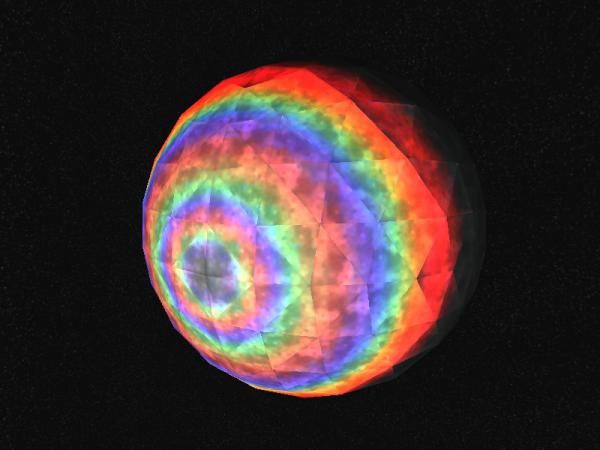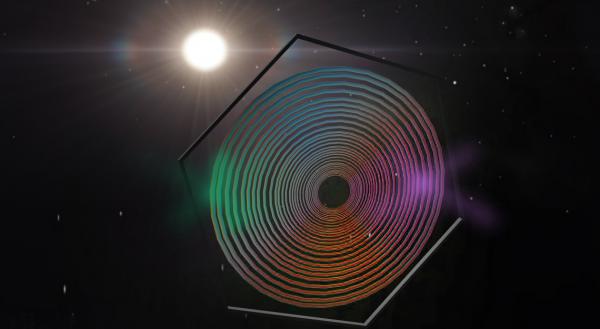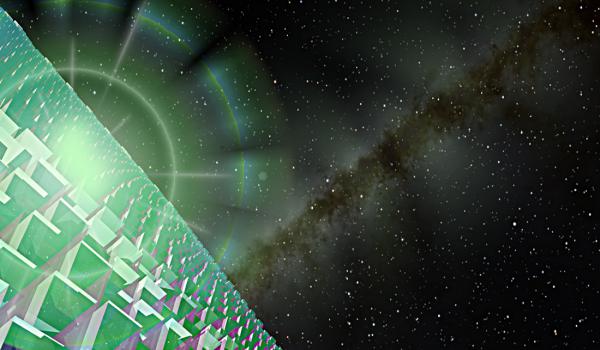BY LETTER
Refractory, The
Technology > Application > Infrastructure
Galactography > Regions of Space > Inner Sphere
Technology > Application > Megascale Engineering
Galactography > Regions of Space > Inner Sphere
Technology > Application > Megascale Engineering
Prismatic structure at the L1 point of a planet that projects rainbow-like colours onto its surface |
 Image from Alex Mulvey |
Star: Iota Virginis
Type: F6 III
Luminosity: 9.31
Distance from Sol: 69.8 ly
The Refractory is a set of triangular circular prisms located at the L1 point of a mercurian-type planet, which is approximately .2 AU from its parent star, Syrma (Iota Virginis). The star is an F-class star, emitting white light which is refracted into rainbow colours and projected onto the planet. Thousands of prisms, each 1km thick, are arranged into rings within a flat, circular structure resembling a fresnel lens. The attenuation of light through these prisms is less than 10%, resulting in bright rainbow colors on the planet's surface.
History
One of the S3 transapients overseeing the development of civilization in the system noted that a large lithicgelidian-type planet orbiting far outside of Syrma's habitable zone contained vast quantities of quartz in its crust, as well as in several small rings orbiting the planet. Additionally, some of the moons contained high concentrations of quartz as well. While quartz is a common resource found in abundance in the crust of many planets, Ztrauq (as the S3 mind chose to call it in the early years of the system) contained a much higher concentration of the mineral than average, not to mention the fact that almost 43% of the mass of its rings were composed of quartz.Quartz is a mineral that is found naturally as a crystal. It can be formed into a unique type of glass by being melted. This process results in fused quartz, a glass used since the early information age for its purity, as well as its high melting point. Indeed, fused quartz is an extremely translucent material.
In 4011 the S3 mind decided e wanted to create a set of massive prisms in orbit around the innermost planet of the Syrma system, but at the time could not deviate resources from the construction of civilization taking place in the system. All e could do at the time was make the calculations for the prismatic rings.
Construction did not begin until 4127, when the S3 hoping to create the prisms was able to suspend a sufficient amount of resources from the civilization there and send them to Ztrauq. The resources consisted of construction nanoswarms as well as many large industrial-adept vecs. The objective of the swarms and vecs was to launch all the quartz from the planet into a closer orbit around Syrma. Due to thermal expansion, the prisms would have to be formed where they were intended to finally be.
It took many years for all of the matter to reach the intended orbit closer to the star, along with it taking many years for all quartz to be launched in the first place. The vecs and nanoswarms worked endlessly and efficiently over the course of more than three centuries to send all of the required matter towards the star. In the end, the rings of Ztrauq were completely depleted of quartz, and its moons and crust were torn to bits. Unfortunately, even after all of the quartz from the planet and its surrounding masses was extracted, more was still needed. The S3 had foreseen this and requested additional supplies from neighboring systems that were already intending to send ships. Through these efforts, all 2.42 sextillion grams of quartz required were obtained.
 Image from Steve Bowers | |
| The prism rings are located at this planet's L1 point | |
Once it reached Syrma, the quartz continued on its designated path around the star, melting into a liquid from the stars heat. Heat-resistant nanoswarm filters were established that the liquid matter passed through, and any atoms not part of quartz (SiO2) were extracted and sent into the star. The remaining quartz, now in the purest form possible, continued on an orbit into the molding section of the process.
Because of the effects such extreme temperature changes would have on such a large object where angles are a critical component, each of the prisms had to be molded entirely at once as a single object. The S3 created numerous giant molds, which were to later be repurposed as parts of a megastructure. The molds were created to form the liquid quartz into what was to be their final shape, then send it into orbit around the inner planet that was to reflect the rainbows cast by the prism.
Once each prism was finished, the mass was extraordinary. Rather than manually move them to where they needed to be, the molds had already been sent into an orbit which would take them where they had to end up. This orbit, along with how long it would take to fill the molds, how much the force of the quartz impacting the sides of the molds would affect the orbit, the amount of quartz present in particular orbits and how long it stayed there, as well as when it got there, had all been related in the calculations of the S3 mind. Many take for granted just how fragile such a process can be.
Finally, once the molds reached their orbit around the inner planet, they were removed to reveal the solid, fused quartz triangular circular prisms, which were linked together to form rings. Their effect was of course noticeable immediately; a spectacular view, intended to be viewed from high orbit beyond, provided a triple rainbow reflected off the planet's surface. Thus, The Refractory was completed.
The time required to complete the prisms was immense; 920 years, including planning. A large portion of that time was simply waiting for certain scenarios to fall into place; certain orbits, such as the molds, could only begin at a certain time of the process.
 Image from Steve Bowers | |
| Close-up of the massive prisms that make up the Refractory | |
Related Articles
Appears in Topics
Development Notes
Text by Alex Mulvey
additional material by Steve Bowers
Initially published on 16 April 2015.
additional material by Steve Bowers
Initially published on 16 April 2015.






